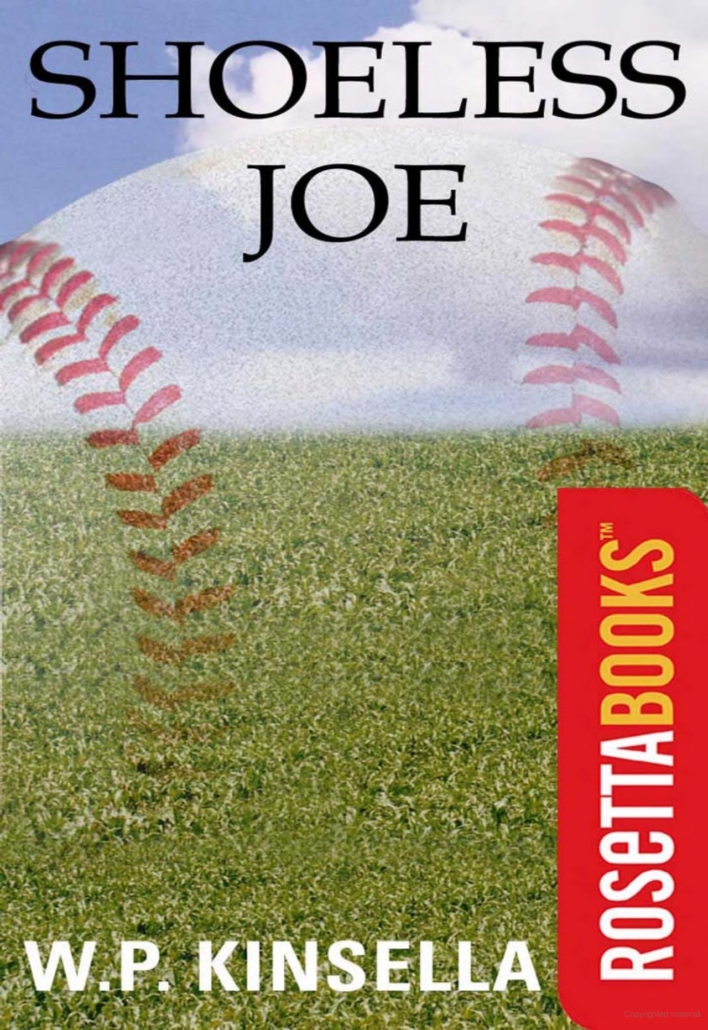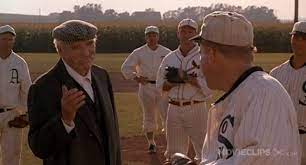FIELD OF DREAMS
FIELD OF DREAMS: film as an aphorism
by Norman Warwick

Field of Dreams is a 1989 American sports fantasy drama film written and directed by Phil Alden Robinson, based on Canadian novelist W. P. Kinsella‘s 1982 novel Shoeless Joe.
The film stars Kevin Costner as a farmer who builds a baseball field in his cornfield that attracts the ghosts of baseball legends, including Shoeless Joe Jackson (Ray Liotta) and the Chicago Black Sox. Amy Madigan, James Earl Jones and Burt Lancaster (in his final film role) also star.
The film was released on May 5, 1989. It received generally positive reviews from critics, and was nominated for three Academy Awards: Best Picture, Best Original Score and Best Adapted Screenplay. In 2017 it was selected for preservation in the United States National Film Registry by the Library of Congress.

The film´s central character is, perhaps, Kostner´s Ray Kinsella, (shown right in a scene from the film) who lives with his wife, Annie, and daughter, Karin, on their corn farm in Dyersville, Iowa. Troubled by his broken relationship with his late father John, a devoted baseball fan, Ray fears growing old without achieving anything.
While walking through his cornfield one evening, he hears a voice whispering, “If you build it, he will come.” He sees a vision of a baseball diamond in the cornfield and “Shoeless” Joe Jackson (who in real life died in 1951) standing in the middle. Believing in him, Annie lets him plough under part of their corn crop to build a baseball field, at risk of financial hardship.
As Ray builds the field, he tells Karin about the 1919 Black Sox Scandal. Several months pass, and just as Ray is beginning to doubt himself, Shoeless Joe reappears, asking if others can play, and returns with the seven other Black Sox players. Annie’s brother, Mark, can’t see the players. He warns the couple they are going bankrupt and offers to buy their land. The voice, meanwhile, urges Ray to “ease his pain.”
Ray and Annie attend a PTA meeting, where she argues against someone who is trying to ban books by Terence Mann, a controversial author and activist from the 1960s. Ray deduces the voice was referring to Mann, who had named one of his characters “John Kinsella” and had once professed a childhood dream of playing for the Brooklyn Dodgers. That night, after Ray and Annie have identical dreams about Ray and Mann attending a game together at Fenway Park, Ray drives to Boston to find him. Mann, who has become a disenchanted recluse, agrees to attend one game. There Ray hears the voice urging him to “go the distance”, seeing statistics on the scoreboard for Archie “Moonlight” Graham, who played in one game for the New York Giants in 1922 but never got to bat. Mann also admits to hearing the voice and seeing the scoreboard.
The pair drive to Chisholm, Minnesota, and learn that Graham, who became a physician, had died years earlier. Ray researches Graham, whose obituary said he was a beloved and charitable doctor, but makes no mention of his baseball career. Ray suddenly finds himself in 1972, and meets an elderly Graham, who feels his calling in life is medicine, not sports, and declines to visit Ray’s baseball field. During the drive back to Iowa, Ray and Mann pick up a young hitchhiker named Archie Graham, who is looking for a baseball team to join. Ray later tells Mann that his father dreamed of being a baseball player, then tried to make him pick up the sport instead. At 14, after reading one of Mann’s books, Ray stopped playing catch with his father, and they became estranged after he mocked John for having “a hero who was a criminal.” Ray admits that his greatest regret is that his father died before they could reconcile. Arriving at the farm, they see various all-star players of the 1920s have arrived, fielding a second team. A game is played and Graham finally gets his turn at bat.
The next morning, Mark returns, demanding that Ray sell the farm or the bank will foreclose on him. Karin insists that people will pay to watch the ballgames. Mann agrees, saying that “people will come” to relive their childhood innocence. Ray and Mark scuffle, accidentally knocking Karin off the bleachers. Graham — despite knowing he will be unable to return after stepping off the field — saves her from choking on a hotdog. Having become old Doc Graham again, he reassures Ray that he has no regrets. As he heads back toward the cornfield, he is commended by the other players, and before he can disappear into the corn, Shoeless Joe calls out, “Hey, rookie!”, Graham stops and turns to Shoeless Joe, who tells him, “You were good.” Doc Graham’s eyes shine with tears before he smiles, turns back toward the corn, and disappears into it. Suddenly, Mark too can see the players and urges Ray to keep the farm.
Shoeless Joe invites Mann to enter the corn, and Mann disappears into it. Ray is angry at not being invited but Joe rebukes him, glancing towards the catcher at home plate, saying, “If you build it, he will come.” When the catcher removes his mask, Ray recognizes him as his father, John, as a young man. Ray then decides that “ease his pain” must have meant his father, but Shoeless Joe quietly says it meant Ray’s own regrets.
Ray introduces John to his wife and daughter, initially without referring to him as his father. As John begins to head towards the cornfield, Ray, calling him “Dad”, asks if he wants to have a catch. John gladly accepts as hundreds of cars are seen approaching the field, fulfilling the prophecy that people will come to the field to watch baseball.
That final scene, which depicted really a stream of car headlights stretching back for miles as they approach the ´basebal park´ was incredibly brought vividly to life after I had come here to live on Lanzarote. Regular readers will know how much we love the live arts on this island and the numerous interventions and installations created by the late artist Cesar Manrique to whom the indigenous people, and many new residents like ourselves, remain in thrall.
Arguably one of Manrique´s most astounding achievements was to envisage and to build an underground theatre and out to the sea at Jameos Del Agua. Not only is it a feat of incredible engineering but it is also, literally, a work of art. Not sure of what time to allow for our journey when making our first visit we arrived an hour or so early, just as the sun was setting. An hour later we weren´t even sure that anyone else was going to arrive, at least not until we saw a long, snaking slow moving queue of traffic, headlights gleaming in the dark. People thought that Kinsella´s field of dreams, a baseball diamond, where no games had ever been played was a ´folly´, just as many people on Lanzarote might have expected to the theatre at Jameos Del Agua might be Manrique´s folly.
I loved, and still love the film Field Of Dreams. After my first viewing I went on to watch it two or three times a year for several years. I hadn´t watched it, though, since coming to live here on Lanzarote in 2015. But whilst channel-hopping on tv recently I stumbled on the opening music of the film, and pretty much cried my eyes out for the next ninety minutes.
The cast, listed below, was still the same fine ensemble I remembered, and Burt Lancaster´s performance was beautifully understated.

Kevin Costner as Ray Kinsella
Amy Madigan as Annie Kinsella
Gaby Hoffmann as Karin Kinsella
James Earl Jones as Terence Mann
Ray Liotta as Shoeless Joe Jackson
Timothy Busfield as Mark
Kelly Coffield Park as Dee, Mark’s wife
Burt Lancaster as Dr. Archibald “Mooight” Graham (shown left in a scene from the film)
Frank Whaley as young Archibald Graham
Dwier Brown as John Kinsella
Lee Garlington as Beulah Gasnick
Michael Milhoan as Buck Weaver (3B)
Steve Eastin as Eddie Cicotte (P)
Charles Hoyes as Swede Risberg (C)
Art LaFleur as Chick Gandil (1B)
In addition, Anne Seymour, who died four months before the film’s release, makes her final film appearance as the kindly Chisholm publisher who helps Ray and Mann. The identity of the actor who provided “The Voice”, who speaks to Ray throughout the film, has remained unconfirmed since the film’s release. Some believe it is Costner or Liotta, but the book’s author W. P. Kinsella said he was told it was Ed Harris (Madigan’s husband). Then teenagers, Matt Damon and Ben Affleck were extras in the Fenway Park scene.
I know nothing about baseball, but the film isn´t really about baseball. It is, rather, a film of popular aphorisms, follow your dream: build it and they will come. It is in some ways a film not only about betrayal, but also of apology and redemption.
I think what I most love about the film, though is the concept of a dreamer, Costner, in search of a writer, himself a dreamer, too, albeit one in recluse.
The film is also a story about how truth and untruth are so often inter-changeable and why the word story is employed to both fiction and non-fiction.




Leave a Reply
Want to join the discussion?Feel free to contribute!